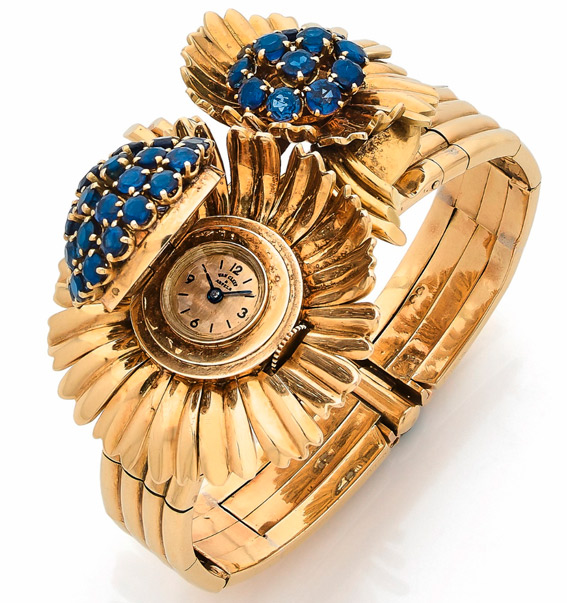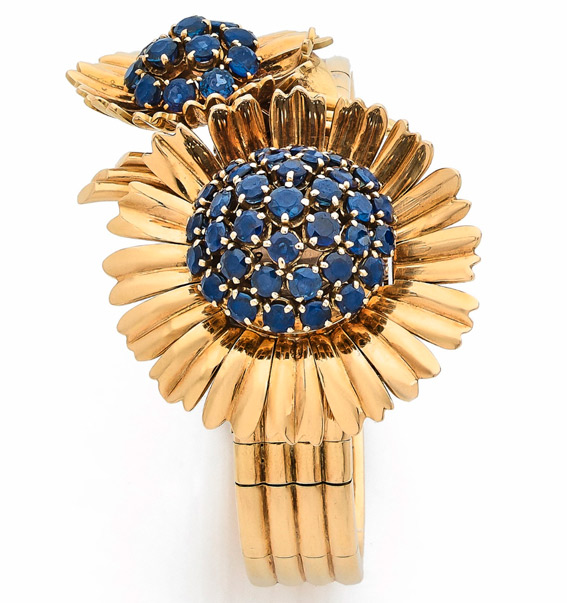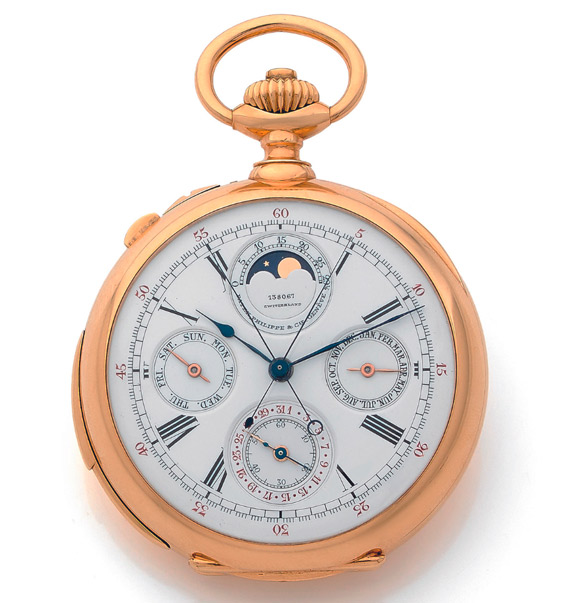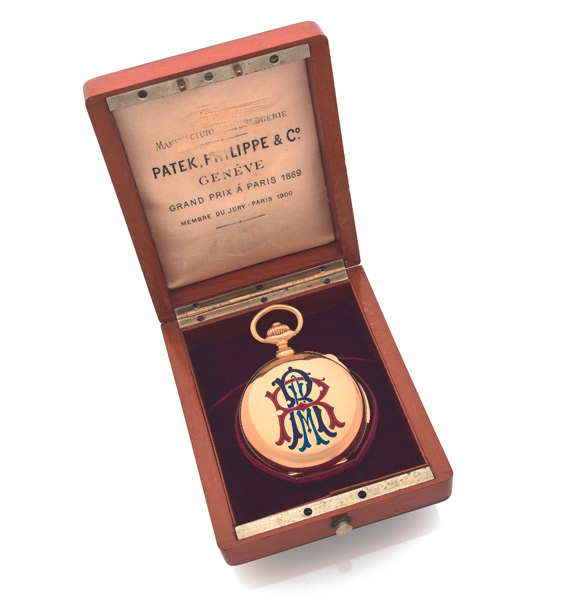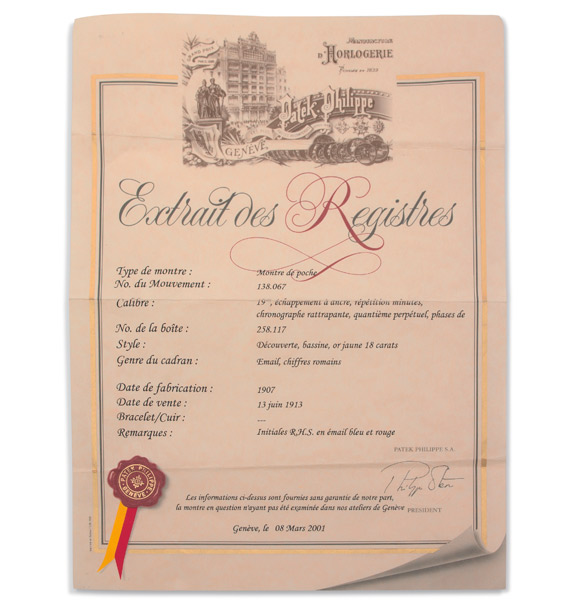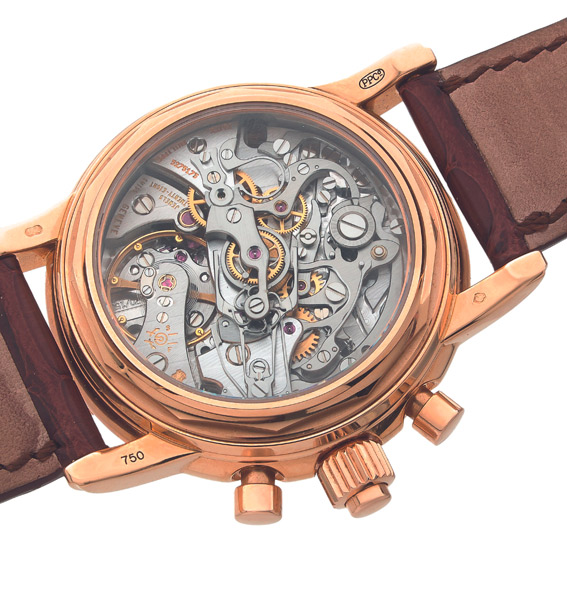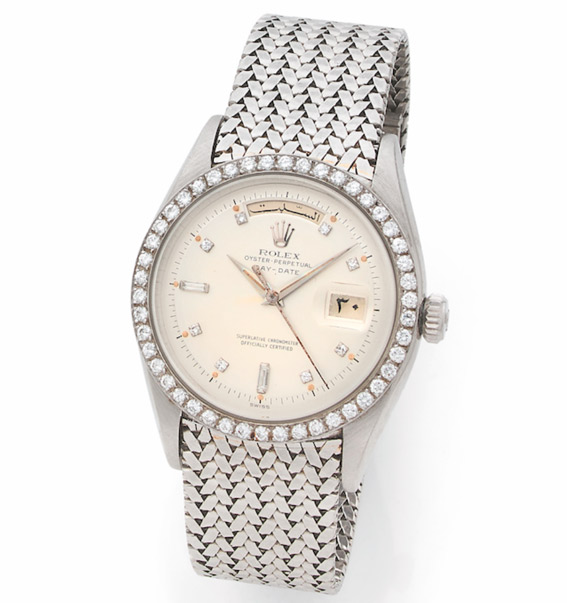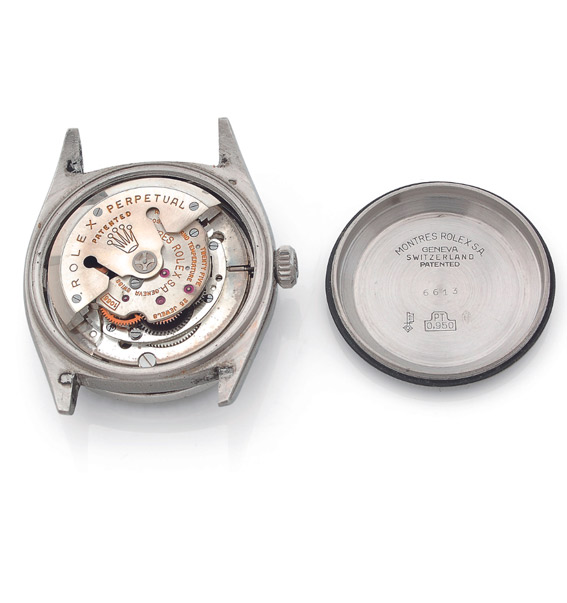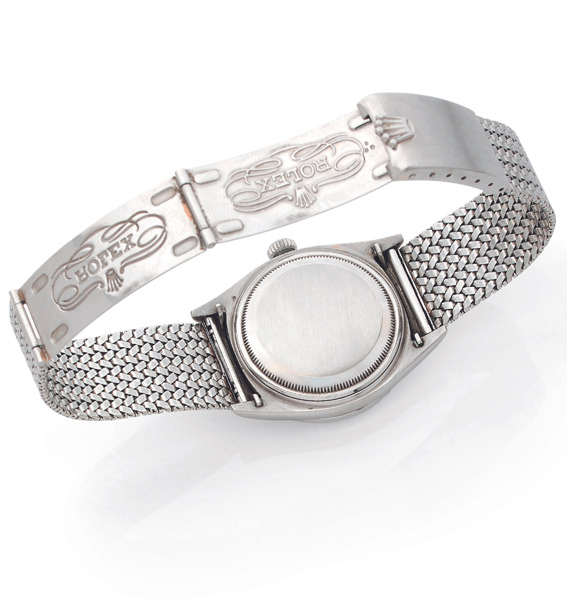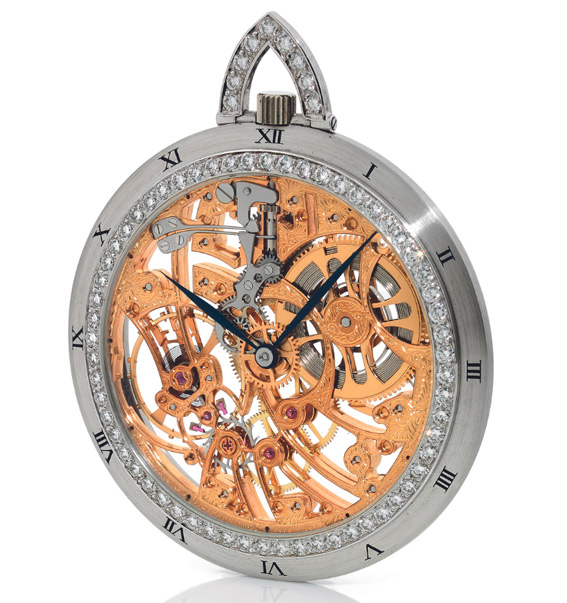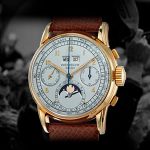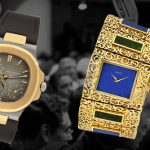Monaco sets the tone with the first watch auction of the year !
As it does every year, Artcurial will be inaugurating the New Year’s auctions. With its much-anticipated “Horlogerie de Collection” sale on 15 January 2024, followed on 16 January by an ultra-glamorous sale dedicated to women’s timepieces, “Le Temps est féminin”, France’s leading auction house has put together a particularly fine selection.
Some of the 160 timepieces up for sale are particularly exceptional, both for their history and their rarity.
#1. VAN CLEEF & ARPELS
« Flower watch », circa 1938
A yellow gold and sapphire-set manual winding watch, concealed dial, mounted on a brooch and convertible into a wristwatch, case stamped Encausse & Krasker, gold extensible bracelet
In the 1920s, watches with concealed dial are introduced for the first time in the Van Cleef & Arpels collections. These mechanical jewels, which elegantly reveal the time, were to become one of the house’s great specialities.
Reinterpreting the most beautiful things nature has to offer, Van Cleef & Arpels developed a line of flower watches from the 1930s onwards. Inside a gold plant element, subtly set with precious stones, the jeweller concealed a miniature watch mechanism. Complex and technical, these extremely glamorous and sophisticated timepieces arouse surprise and wonder. The jeweller’s desire to surprise his clientele became a major creative focus, and he developed pieces that could be transformed. It was by imagining hybrid creations, such as this flower bracelet that metamorphoses into a ravishing brooch, that Van Cleef & Arpels established itself as one of the most creative names of the 1940s.
Absolutely magical, this fabulous collector’s item was designed in 1938. This watch is a genuine rediscovery and is listed in the Van Cleef & Arpels archives, as the brand has the original gouache drawing (no. 50308) in its Heritage department. This unique collection includes several preparatory drawings, archives and order registers. Although the name of its first owner has not been revealed, it is likely that this watch was delivered to a prominent French family, as it is a particularly elaborate piece, and it should be noted that gold jewellery and watches were becoming rarer at the time, as the war effort prohibited the export of gold from 1939 onwards. Although a few very rare examples have been found, no similar models have appeared in auction rooms in recent years. The case bears the fish of the Encausse & Krasker workshop. Located at 32 rue Coquillière, in the 1ᵉʳ arrondissement of Paris, Encausse & Krasker was founded in 1910 by Etienne Encausse and Albert Krasker. Very active until the end of the 1930s, they worked mainly for the great jewellers of Place Vendôme, such as Van Cleef & Arpels, Boucheron and René Boivin, to whom they supplied watch movements and watch cases stamped with the “E&K” hallmark. So, in addition to the prestigious Van Cleef & Arpels signature, there is the mark of a renowned workshop. It should be noted that in recent years, these subcontracting workshops have benefited from a major revaluation. In the past, master hallmarks were rarely seen, but today – when they are legible – they can considerably increase the value of a watch or piece of jewellery. This unusual ‘flower watch’ will be offered for sale with an estimate of €35,000 / €45,000. For fans of unusual timepieces, this flower-watch represents a unique opportunity to acquire an exceptional collector’s item.
#2 PATEK PHILIPPE
Grande complication “Artemas Roscoe Roberts », circa 1907
A yellow gold keyless pocket watch, Grande Complication, split seconds chronograph, perpetual calendar, moon phase and minute repeater, made for Artemas Roscoe Roberts Waco, Texas 1913 by Patek Philippe & Co
This very attractive watch is one of the most marvellous “Grande Complication” watches produced by Patek Philippe between 1895 and 1970. These watches, of great horological prowess, most often combined particularly sophisticated complications: perpetual calendar and phases of the Moon, chronograph with split-seconds and minute repeater. Our example can be compared with the production delivered to the American market at the beginning of the 20ᵉ century. By 1890, the Geneva manufacture had acquired a substantial clientele across the Atlantic, thanks in particular to its partnership with the prestigious retailer Tiffany & Co. The first owner of this watch was the American architect Artemas Roberts (1841 – 1944), whose name is engraved on the gold case. Born in Indiana in 1841, Artemas Roberts moved to Lincoln, in the heart of Nebraska, where he opened an architectural practice. In 1887, he joined forces with architect Alfred W. Woods to found Roberts & Woods Architects. This collaboration gave rise to a number of architectural achievements, including Fairview House, their most famous project, which was designed for one of the most influential politicians of his time: William Jennings Bryan, the Democratic candidate in the presidential elections of 1896, 1900 and 1908. Artemas Roberts’ many buildings in the city of Lincoln, and more widely in Nebraska, made him extremely popular, and he is a well-known figure in his home state. On 27 October 1941, for example, Lincoln’s Evening State Journal devoted an article to him on the eve of his 100ᵉ birthday. Artemas Roberts died in 1943 at the age of 102 in Florida.
His watch, in a beautiful state of preservation, is accompanied by its period case as well as its certificate of origin. It is extremely rare that watches of such high quality are still accompanied by all their period accessories and documents. In the early 20ᵉ century, Patek Philippe had a large American clientele, and while the names James Ward Packard and Henry Graves Jr. remain the most famous, other great enthusiasts also carried the brand across the Atlantic. Artemus Roberts, whose personal history is closely linked to that of the United States, is one of them, and his watch is a museum-quality piece comparable to those on display today at the Patek Philippe Museum in Geneva.
Estimated at between €120,000 and €180,000, this watch should be compared with the grand complication sold by Christie’s on 11 June 2013 (lot 71, Important Watches New-York) and once owned by the American businessman Stephan S. Palmer. Sold in 1900 by Patek Philippe to the billionaire, this watch was accompanied by its certificate of origin and its period wooden case. Equipped with the same complications as the superb watch to be presented by Artcurial, Stephan S. Palmer’s watch fetched $2,251,750 at the time.
#3. PATEK PHILIPPE
A rose gold split-second chronograph with perpetual calendar and moon phases, ref. 5004R-014, circa 2008
Patek Philippe remains the most popular brand among collectors and complication watches have enjoyed a resurgence of interest in recent months, and this timepiece is a must-see in this sale.
Launched in 1994 and produced until 2012, reference 5004 is the first perpetual calendar chronograph with moon phases and split-seconds function produced by Patek Philippe. For any connoisseur, the split-seconds function is one of the finest complications in watchmaking. Particularly delicate to develop on a perpetual calendar, it would take Patek Philippe several years of research before being able to bring this technical feat to fruition. So, after marketing its first perpetual calendar chronograph in 1941, it was only 50 years later that the brand succeeded in adding a split-seconds function and thus making it a grand complication.
The aesthetics of the watch are inspired by the reference 3970, itself inspired by the iconic ref. 2499. Its remarkably small case measures exactly 36.5 mm. By housing such sophisticated complications in such a small cavity, Patek Philippe has created one of its finest technical feats.
Considered one of the brand’s most emblematic timepieces, the ref. 5004 was exceedingly complex to produce, and the total production run is estimated at around 200 watches, all precious metals combined. The example to be presented on 15 January (lot 86) is in pink gold, indisputably the most elegant version. Estimated at between €100,000 and €150,000, this exceptional timepiece could trigger a fine auction battle, like the similar reference that sold for more than €300,000 a year ago at Artcurial (lot 280, Horlogerie de Collection, 16 january 2023).
#4. ROLEX, Pièce Historique
Day Date “The Eastern Arabic”, ref. 6613B, vers 1958
A platinum and diamond-set wristwatch with day and date indication (Arabic script)
Patek Philippe may be the market leader in collector’s watches, but Rolex is always close behind. At the start of this year, a historic Rolex timepiece will be making its first appearance on the market: an extraordinary ref. 6613B/6613.
Introduced in 1957, ref. 6613 is one of the rarest watches produced by Rolex. Sold exclusively in platinum, only a handful of examples have ever been delivered to the market. Our example, fitted with an oriental Arabic Persian calendar, is at first glance similar to the watch illustrated in John Goldberger’s book “100 Superlative Rolex Watches” (Damiani Libri Edition, 2008, p. 163). However, the watch offered for sale bears reference 6613B, a much rarer version.
According to our research, at least two equivalent references were presented at auction. Presented to Lebanese Prime Minister Rachid Karamé by King Saud bin Abdelaziz Al Saud of Saudi Arabia, this unrivalled collector’s item is being presented for the first time at public auction. Mounted on a platinum bracelet with a “Big logo” folding clasp, this watch is an atypical piece in Rolex production. Consigned to the heirs of Mr Rachid Karamé, this timepiece has been kept intact since the death of the Prime Minister on 1ᵉʳ June 1987. Because he remained a key politician in the history of the Middle East, his watch is a historic collector’s item, which enthusiasts will appreciate for its exceptional state of preservation.
King Saud bin Abdelaziz Al Saud is the son of the founder of the Saudi dynasty. He was King of Saudi Arabia from 1953 to 1964. After being deposed, he took refuge in Europe, notably in Geneva and on the Côte d’Azur, where he stayed for several years. He died in Greece at the age of 67.
#5. AUDEMARS PIGUET
“Lépine Squelette”, ref. 5656BC, circa 1975
A platinum and diamond-set skeleton watch
Audemars Piguet is one of the most popular brands among collectors and enthusiasts, after Patek Philippe and Rolex, and is preparing to take an unprecedented turn following the departure of its CEO François-Henri Bennahmias.
If this watch is particularly interesting, it is because it was manufactured in 1975, a period when the Swiss watchmaking industry was experiencing an unprecedented crisis following the invention of the first quartz watch by the Japanese in 1969. Faced with this quartz revolution, the historic manufactures responded by reasserting their “Swiss made” expertise. While Patek Philippe made a return to complications, Audemars Piguet produced several skeletonised timepieces during this period. By revealing the architecture of the movement, the brand celebrated traditional watchmaking.
As a perfect illustration of this period of renewal in the history of Audemars Piguet, this watch was chosen by François Chaille, the author of the book “Audemars Piguet, le maître de l’horlogerie depuis 1875” (Édition Flammarion, Paris, 2011), where it is reproduced on page 92.
While this model is already familiar to enthusiasts of the brand thanks to this reference work, the piece on offer will be presented for the first time on the market (lot 131, Le Temps est Féminin, 16 January 2024).
Kept by its original owner since it was acquired from the jeweller Leysen Frères in Brussels, this dinner jacket watch is a piece of rare elegance. Accompanied by the period catalogue, in which it is reproduced on the second page, its sole owner kept a message from the authorised Audemars Piguet retailer. He invited her to notice “the famous ‘skeleton’ watch, with every part of the movement in finely chased gold”. The prospectus at the time already emphasised that it was “an exceptional work of art that will be the pride of a privileged few. “. Available for 400,000 Belgian francs at the time, only a few examples of reference 5656BC were made.
In an astonishing state of preservation, this collector’s item reveals all the beauty of Le Brassus’ inimitable watchmaking expertise.





